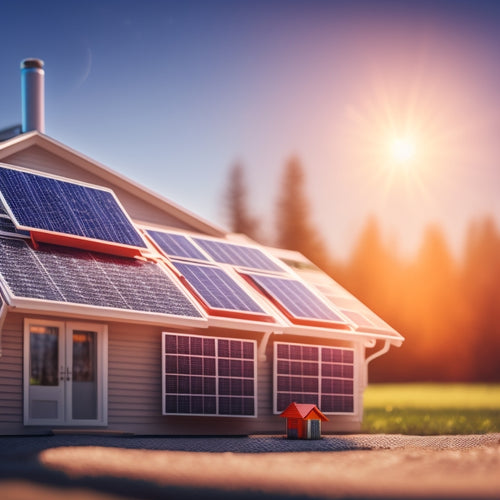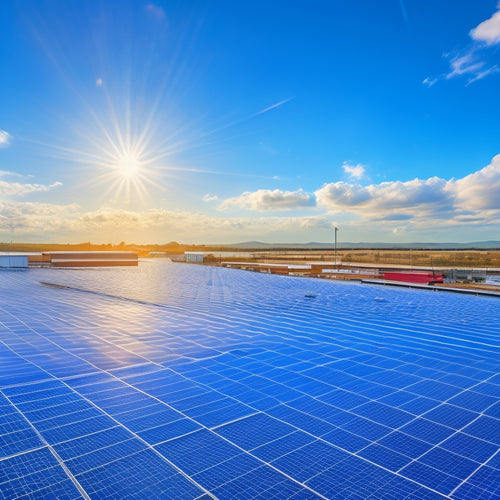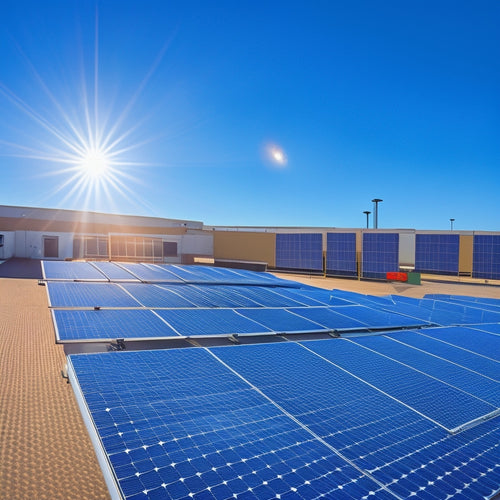
Solar Array for Home
Share
You're considering installing a solar array for your home, a smart move that can greatly reduce your reliance on the grid and lead to potential zero energy bills. By utilizing free renewable energy, you'll not only minimize your carbon footprint but also increase your property value. With high-efficiency solar panels converting up to 22% of sunlight into usable electricity, you can enhance your energy output. However, it's crucial to assess your roof's shading patterns and refine your solar array's design to guarantee peak performance. Now that you've taken the first step, investigate the key factors that'll help you make the most of your solar investment.
The Essentials
- Solar arrays can eliminate energy bills by generating sufficient electricity, providing energy independence and long-term savings.
- Combining solar with energy storage systems ensures reliable power supply and backup during outages, maximizing the benefits of going solar.
- High-efficiency solar panels convert more sunlight into usable electricity, with modern panels achieving conversion rates of up to 22%.
- A well-designed solar array can enhance a home's exterior, attracting potential buyers and boosting property values by up to 17%.
- Conducting shading analysis and exploring solutions can minimize the effects of shading on energy production, optimizing the solar array's performance.
Harness Free Renewable Energy
You're about to tap into a renewable energy source that's abundant and freely available: sunlight.
By utilizing this energy, you'll greatly reduce your reliance on the grid, potentially leading to zero energy bills.
With a solar array for your home, you'll be generating clean power and reaping the financial benefits that come with it.
Renewable Energy Source
Your solar array is a gateway to utilizing free renewable energy from the sun, a limitless resource that's available everywhere. By capturing this energy, you're not only reducing your reliance on fossil fuels but also decreasing your carbon footprint.
As a homeowner, you're entitled to solar incentives that can greatly offset the cost of installing a solar array. These incentives can include tax credits, rebates, and even net metering laws that allow you to sell excess energy back to the grid.
By integrating a solar battery storage system into your setup, you can store excess energy generated during the day to use at night or during power outages, and gain more control over your energy bills.
With a solar array, you're generating clean energy during the day, which can be stored in energy storage systems like batteries for later use. This means you can power your home even when the sun isn't shining.
By combining solar energy with energy storage, you're ensuring a reliable and consistent supply of power. This setup also provides backup power during grid outages, giving you independence from the grid.
Zero Energy Bills
As a homeowner, utilizing free renewable energy from the sun translates to significant savings on your energy bills. With a solar array installed on your roof, you can capture the power of the sun to generate electricity, reducing your reliance on traditional energy sources. This means you'll be paying less for energy, and enjoying the benefits of energy independence.
| Benefits | Description |
|---|---|
| Zero Energy Bills | Eliminate your energy bills with a solar array that produces enough electricity to power your home. |
| Solar Incentives | Take advantage of government incentives and tax credits for installing a solar array, reducing your upfront costs. |
| Energy Independence | Break free from reliance on traditional energy sources and enjoy the freedom of generating your own clean energy. |
| Increased Property Value | Enhance your property value with a solar array, making your home more attractive to potential buyers. |
Increases Property Value Fast
You'll be pleased to know that installing a solar array on your home can markedly enhance its sale price.
In fact, many homeowners are turning to sustainable solar roofing solutions to increase their property value.
This is because a solar array adds substantial curb appeal, making your property more attractive to potential buyers.
As a result, you can expect to sell your home faster and for a higher price than you'd without a solar array.
Boosts Sale Price
Installing a solar array on your home greatly improves its sale price, which can lead to a faster and more profitable property sale. As a homeowner, you can increase your property worth by up to 17% with a solar array installation, according to the National Renewable Energy Laboratory.
This significant increase in worth can be attributed to the growing demand for energy-efficient homes and the corresponding market trends. By investing in a solar array, you're making a smart home improvement decision that pays off in the long run, especially considering that renewable energy systems sustainable energy solutions are becoming increasingly popular.
Additionally, with the ability to reduce your energy expenses and enjoy increased energy independence, a solar array installation is a wise investment for any homeowner. Potential buyers are willing to pay a premium for homes with solar arrays, as they recognize the long-term savings on energy bills and the reduced carbon footprint.
In fact, a study by the Appraisal Institute found that homes with solar arrays sell for $15,000 more on average than similar homes without them. By installing a solar array, you're not only reducing your reliance on the grid but also positioning your home as a desirable and significant asset in the market.
This strategic home improvement decision can make a substantial difference in the sale price of your property, giving you a competitive edge in the market.
Adds Curb Appeal
A solar array can instantly enhance your home's curb appeal, making it more attractive to potential buyers and increasing its property value fast. With an aesthetically designed solar array, you can change your home's exterior, creating a modern and eco-friendly impression that connects with potential buyers.
| Design Element | Impact on Curb Appeal |
|---|---|
| Energy Aesthetics | Harmonizes with modern design and surroundings |
| Visual Integration | Blends seamlessly with your home's architectural style |
| Stylish Installations | Creates a sleek, high-tech look that enhances neighborhood appeal |
| Outdoor Harmony | Complements your outdoor space, creating a sense of unity |
| Architectural Style | Raises your home's visual impact, making it stand out in the neighborhood |
Efficient Energy Conversion Rate
You want a solar array that can convert sunlight into electrical energy with high efficiency, and that's exactly what you get with a well-designed system.
A high conversion efficiency rate guarantees that more sunlight is converted into usable electricity, resulting in maximum power output.
With top residential solar panel systems, you can experience renewable energy and sustainable power that reduces your electricity bills and carbon footprint.
High Conversion Efficiency Rate
High-performance solar panels boast a high conversion efficiency rate, which enables them to harness a significant portion of the sun's energy and convert it into usable electricity. This means you can generate more power with fewer panels, reducing the overall cost and environmental impact of your solar array.
With advancements in solar technology, modern panels can achieve conversion efficiency rates of up to 22%. This is a significant improvement from earlier models, which often struggled to reach 15%. The key to this increased efficiency lies in recent photovoltaic advancements, including improved semiconductor materials and optimized panel designs.
As a result, you can enjoy a more efficient energy conversion rate, reduced energy bills, and a smaller carbon footprint. By choosing high-performance solar panels, you're not only investing in your energy independence but also contributing to a more sustainable future.
Maximum Power Output
Between peak sun hours, your solar array's maximum power output is vital in determining how much electricity you can generate. This is the highest amount of power your system can produce under ideal conditions, typically measured in watts (W). Your solar array's maximum power output directly affects your energy independence, as it dictates how much electricity you can utilize from the sun.
To optimize your system's power performance, you should consider factors like the number and quality of solar panels, the type of inverter used, and the system's overall design.
Energy optimization is essential, as even minor inefficiencies can greatly reduce your system's maximum power output. A well-designed solar array with a high maximum power output can provide you with a substantial amount of electricity, reducing your reliance on the grid and giving you the freedom to power your home sustainably.
Assess Your Roof's Shading
You'll need to identify any roof obstructions that could cast shade on your solar array, including chimneys, vents, and skylights.
Consider investing in DIY solar panel kits for an easy and cost-effective installation process.
Shading patterns will vary over time due to seasonal changes in the sun's angle, so it's crucial to assess your roof's shading at different times of the year.
Roof Obstructions to Consider
When evaluating your roof's shading, identifying obstructions is vital to determining the ideal placement of your solar array.
You'll need to take into account roof pitch, as steeper angles can lead to installation challenges and affect solar panel positioning.
Check for debris management issues, such as chimneys, vents, or skylights, which can impact maintenance access and panel orientation.
Confirm that your solar array won't compromise your roof's structural integrity, and verify compliance with local regulations.
Aesthetic considerations are also significant, as the appearance of your solar array can impact your home's curb appeal.
Be mindful of weather exposure, as extreme weather conditions can affect your solar array's performance.
Reflect on the impact of obstructions on your solar array's performance and adjust the positioning accordingly.
By carefully evaluating these factors, you can optimize your solar array's placement and maximize its energy output.
Shading Patterns Over Time
Most roofs experience varying degrees of shading throughout the day and year, primarily due to the sun's movement. To optimize your solar array's performance, you need to understand the shading patterns on your roof. A shading analysis will help you identify areas that receive partial or complete shade, which can greatly impact your solar panel's energy output.
Seasonal variations, such as summer and winter solstices, affect the angle of sunlight exposure, resulting in different shading patterns. In addition, tree growth and nearby obstructions can cast shadows on your roof, further reducing sunlight exposure. Your roof's orientation also plays an important role in determining the amount of sunlight it receives.
To mitigate the shading impact, you can investigate shading solutions like trimming trees, adjusting panel placement, or using specialized equipment to minimize shadow effects.
Weather patterns, like fog or haze, can also influence sunlight exposure, so it's vital to take these factors into account when designing your solar array. By understanding your roof's shading patterns, you can maximize your solar array's energy output and enjoy the freedom that comes with generating your own clean energy.
Higher Energy Density Panels
You're looking for solar panels that can maximize energy production in a limited space.
Higher energy density panels are designed to do just that, allowing you to generate more power per square foot.
Efficient Energy Harvesting
Several factors contribute to the efficiency of solar panels, but none are more critical than the energy density of the panels themselves. You want to maximize your energy harvesting capabilities, and that's where higher energy density panels come in.
With advancements in solar technology, you can now achieve higher energy outputs per unit area, reducing the overall footprint of your solar array. This means you can generate more power with fewer panels, making your system more efficient and cost-effective.
As you investigate energy trends and sustainability practices, you'll find that efficient energy harvesting is key to achieving grid independence. With solar incentives and decreasing installation costs, there's never been a better time to invest in a solar array for your home.
Furthermore, energy storage solutions can help you store excess energy generated during the day for use during the night or on cloudy days. By choosing higher energy density panels, you'll not only reduce your environmental impact but also enjoy lower maintenance tips and increased energy efficiency.
Frequently Asked Questions
How Do Solar Panels Perform During Extreme Weather Conditions?
You'll find that solar panels are designed to withstand extreme weather conditions, boasting impressive durability and resilience. They're built to endure heavy rain, hail, and high winds, ensuring consistent energy production even in the face of Mother Nature's fury.
Are Solar Panels Compatible With All Roofing Materials?
You'll find that solar panels aren't compatible with all roofing materials, and you'll face installation challenges with certain types, like slate or cedar shake roofs, which require specialized mounting systems and careful planning for a secure fit.
Can I Install Solar Panels Myself to Save Money?
You can attempt a DIY installation to save money, but be aware that it requires electrical and roofing skills, and improper installation can void warranties; instead, consider cost-saving tips like shopping around for quotes and claiming tax credits.
How Long Does It Take to Install a Solar Array System?
You'll steer through three project phases: planning, installation, and inspection. Typically, you're looking at 2-5 days for installation, but the entire timeline can stretch from 3-6 months, depending on permits, inspections, and your local utility company's interconnection process.
Do Solar Panels Require Regular Maintenance Checks?
You should expect to perform routine maintenance checks on your solar panels every 6-12 months to guarantee peak performance and extend their lifespan, as regular upkeep can greatly impact solar panel longevity and overall system efficiency.
Final Thoughts
You're now a proud owner of a solar array for your home, utilizing free renewable energy like a boss. Your property value just skyrocketed, and your energy bills are plummeting like a teenager's mood on a Monday morning. Efficient energy conversion rates mean you're getting the most bang for your buck. And, with higher energy density panels, you're basically printing your own money (minus the whole "printing money" thing). Now, go ahead, bask in the glory of your eco-friendly, cost-effective, and totally-not-a-hipster solar array.
Related Posts
-

A Beginner's Guide to Navigating the Solar Investment Tax Credit
You're eligible to claim a significant Solar Investment Tax Credit (ITC) of 30% of total installation costs, but mane...
-

Commercial Solar Energy
As you consider powering your business with commercial solar energy, you'll uncover it offers a triple benefit: signi...
-

Essential Solar Panel Mounts for Commercial Properties
When it comes to essential solar panel mounts for your commercial property, durability and wind resistance are key fa...


